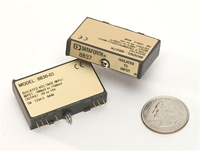Miniature electronics... 8B modules
Tech Note
Modern electronics began around 1907 when the eccentric American inventor Lee De Forest developed and patented a triode vacuum tube. AT&T purchased De Forest's patent and incorporated this vacuum tube as an amplifier in their telephone communication equipment. Unfortunately, vacuum tubes were large and bulky, often unreliable, used too much power, and produced considerable amounts of heat.
In 1945 after World War II, Mervin Kelly, the director of research at Bell Lab's, put together a team of scientists to use the semiconductor research done on diodes in radar systems in order to develop a solid-state semiconductor switch that would replace the vacuum tube. William Shockley was selected as team leader. He drafted Walter Brattian and John Bardeen along with a diverse collection of physicists, chemists and engineers.
By mid 1945, Shockley designed what he believed was the first semiconductor “field effect" amplifier, however, it did not work. Walter Brattian and John Bardeen were assigned to determine why. Unknown to Shockley, Brattian and Bardeen worked on their own ideas and in 1947 demonstrated a “point contact” transistor. Shockley was excited but at the same time furious that he had not been involved in their discovery. In order to preserve his image, he set out to upstage their breakthrough. In a flurry of brilliance and retaliation, he designed (in about 30 days) the first "junction bipolar transistor".
In mid 1948, Bell Labs publicized their work. Amazingly, the announcement got very little attention. Disappointed, Shockley left Bell Labs and started Shockley Semiconductor in California. By some accounts, Shockley’s difficult personality drove away eight of his best and brightest engineers. They went their separate ways and founded Fairchild Semiconductor, Intel Corporation and other companies. Nonetheless, in 1956 Shockley, Bardeen, and Brattian won the Nobel Prize for their work on the "transistor".
Nearly all of the companies that are or have been active in semiconductor technology can trace the technical lineage of their founders back through Fairchild to the Shockley Semiconductor Laboratory. Unintentionally, Shockley contributed to one of the most spectacular and successful industry expansions in history.

Dataforth’s team of design and manufacturing engineers have some of the characteristics of Shockley’s team. They are indeed among some of the best and brightest; moreover, they are a cohesive well managed team individually focused on the common goal of producing the highest quality products and lowest cost. Dataforth's newest innovation has miniaturized another familiar electronic device - the analog signal conditioner! Dataforth's 8B module has reduced earlier designs to 20% the size at a lower cost yet still provide "Instrument Class" performance.
We invite you to read-all-about-it at: SensorLex™ 8B Module
Remember, our Application Engineers can assist you with signal conditioner selection over the phone or via fax and email. Call us at our manufacturing facility in Tucson at 520-741-1404 (fax 520-741-0762) or Email us at support@dataforth.com.






